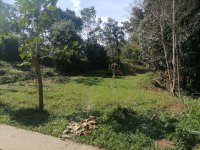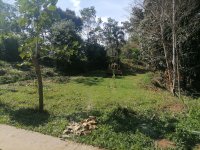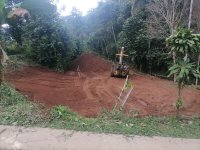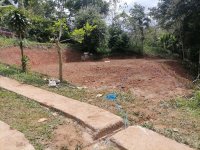Sebculb
Gold Member
Hey everyone,
So I had a small field that for outdoor crops like beans, corn, squash, etc. (as opposed to greenhouse crops cuz your veggies in the tropics like protection from the rain) Like a 200m2 piece of land. It was a little sloped, just enough so it was very difficult to work with a walk behind rototiller.
Wanted to flatten it out and make it bigger. So when I had about a week free with no jobs started by scraping up a ginormous mountain of topsoil to one corner with my Deere 310d backhoe and then began cutting subsoil off the back side and filling off the front. Lotsa careful compacting cuz I don't want this sliding off when it starts raining again in April.
After I finished cutting and filling the first half I moved the mountain of topsoil over and started leveling the other side. After that I spread the topsoil out again over the whole thing.
The soil here is real clayey so I got a dumptruck of river sand delivered and spread it out. Then tried to rototill it in but the field was compacted as hard as a parking lot so had to break up the first several inches with the hoe. Then it rototilled just fine with a walk behind rear tine tiller. Got a bunch of manure from the pigs and chickens (gotta constant supply that we till in before every planting) and some sacks of lime and tilled that all in.
Now we're trying to establish erosion control plantings on the front fill wall and back cut wall using sprinklers during tropical dry season.
Increased the size of the field by about a third to 300m2, cutting off the back and filling off the front. Now it's super flat and easy to rototill. In this mountainous terrain if you want something flat you have to make it flat, that's why my farm machinery is a construction backhoe instead of an agricultural tractor.
Hardpan issues are going to be off the charts. Have to see how this first planting goes and work from there. Got like 4-6" of sandy topsoil and rock hard compacted clay underneath. I mostly like to plant beans and they aren't very deeply rooted. Suppose I can just "chisel plow" it deeper with the backhoe if necessary.
Starts raining at the end of March, looking forward to planting it and seeing how it works.
Most expensive beans ever. Like four days of machine work, $200 of sand, paying some farm hands, water bill for establishing the erosion control, etc.
Posting this text and I'll see about some pictures.
So I had a small field that for outdoor crops like beans, corn, squash, etc. (as opposed to greenhouse crops cuz your veggies in the tropics like protection from the rain) Like a 200m2 piece of land. It was a little sloped, just enough so it was very difficult to work with a walk behind rototiller.
Wanted to flatten it out and make it bigger. So when I had about a week free with no jobs started by scraping up a ginormous mountain of topsoil to one corner with my Deere 310d backhoe and then began cutting subsoil off the back side and filling off the front. Lotsa careful compacting cuz I don't want this sliding off when it starts raining again in April.
After I finished cutting and filling the first half I moved the mountain of topsoil over and started leveling the other side. After that I spread the topsoil out again over the whole thing.
The soil here is real clayey so I got a dumptruck of river sand delivered and spread it out. Then tried to rototill it in but the field was compacted as hard as a parking lot so had to break up the first several inches with the hoe. Then it rototilled just fine with a walk behind rear tine tiller. Got a bunch of manure from the pigs and chickens (gotta constant supply that we till in before every planting) and some sacks of lime and tilled that all in.
Now we're trying to establish erosion control plantings on the front fill wall and back cut wall using sprinklers during tropical dry season.
Increased the size of the field by about a third to 300m2, cutting off the back and filling off the front. Now it's super flat and easy to rototill. In this mountainous terrain if you want something flat you have to make it flat, that's why my farm machinery is a construction backhoe instead of an agricultural tractor.
Hardpan issues are going to be off the charts. Have to see how this first planting goes and work from there. Got like 4-6" of sandy topsoil and rock hard compacted clay underneath. I mostly like to plant beans and they aren't very deeply rooted. Suppose I can just "chisel plow" it deeper with the backhoe if necessary.
Starts raining at the end of March, looking forward to planting it and seeing how it works.
Most expensive beans ever. Like four days of machine work, $200 of sand, paying some farm hands, water bill for establishing the erosion control, etc.
Posting this text and I'll see about some pictures.
Last edited:




